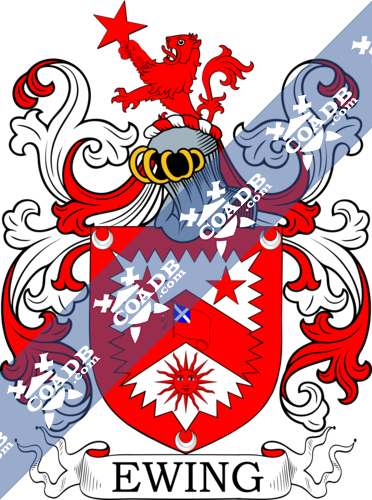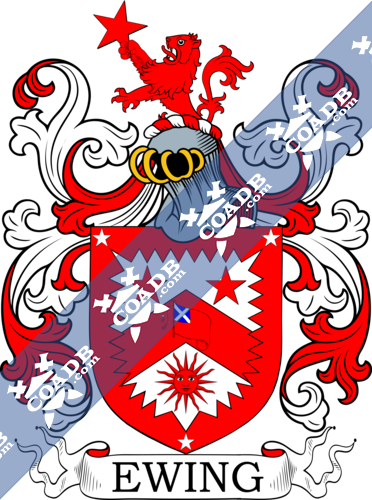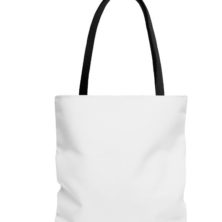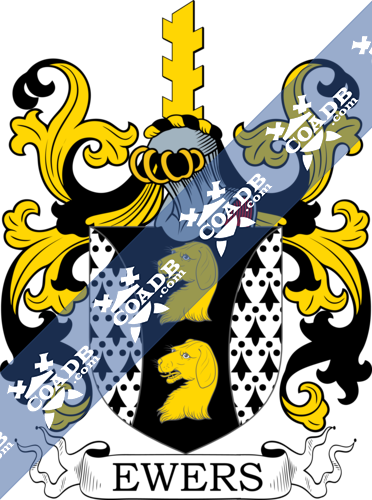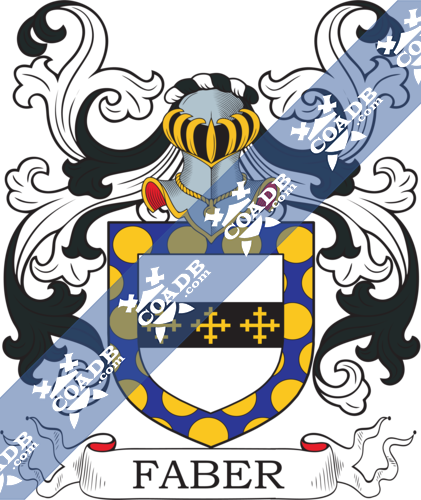Ewing Family Crest, Coat of Arms and Name History

Ewing Coat of Arms Gallery
Don’t know which Coat of Arms is yours?
We can do a genealogical research. Find out the exact history of your family!
Learn MoreEwing Origin:
Ireland, Scotland
Origins of Name:
The surname of Ewing is a patronymic surname, meaning it comes from the derivative of “son of Ewan.” The name Ewan is of a Scottish origin, and is an Anglicized form of the Irish Gaelic personal name of Eogann. Today, this name is acknowledged as being a Gaelic form of the Latin personal name “Eugenius” which derives from the Greek personal name of “Eugenios” which translates to meaning well-born, and noble. “Eugenios” was once believed to be a form of the personal name John, which was derived from the Hebrew name “Johanan” which means Jehovah has favored thee. Another possible origin of this name is a proto-Celtic name which means “born of the yew.” This name was first recorded as a personal name in the Doomsday Book of 1086 (which encompassed the “Great Survey”) for the county Herefordshire, and was recorded as “Ewen” and “Ewei” as a personal, first name, rather than a surname.
Variations:
More common variations are:
Ewen, Ewens, Eweing, Euwing, Ewingg, Eiwing, Ewuing, Yewing, Ewinng, Ewinng, Eing, Ewng, Hewen, Yewen, Ewings, Youens, Eunson, Hewins
History:
England:
The first recorded spelling of the surname Ewing, was in the Pipe Rolls of Warwickshire which was recorded as Walter Ywain in 1202, and under the reign of King John, who was known as “Lackland” and ruled from the year 1199 to the year 1216.
Scotland:
The surname of Ewing came from the Dalriadan clans of ancient Scotland, and the Ewing family was first established in the region of western Scotland known as Argyllshire, and corresponding to the ancient Kingdom of Dal Riata, in the Strathclyde region of Scotland. This area is now a part of the Council Area of Argyll and Bute, where the Ewing family has been said to have held a family seat since ancient Scottish times. In Scotland, the first recorded spelling of the Ewing surname was in Dovenaldus Ewain, who was documented in the year 1164. Because this name was derived from a Gaelic word, the spelling may vary from location to location. Many Scottish people bearing the surname of Ewing migrated to North America, settling mostly in the United States, but then migrating North to Canada during the Revolutionary war. The first recorded person bearing the surname Ewing to migrate to the United States of America was Thomas Ewing, who arrived in Long Island, New York in the year 1718. In the 19th Century, John Ewing settled in America in 1803, and William Ewing arrived in America in 1809, while Wm Ewing, who was twenty-five years of age, settled in the state of Virginia in the year 1812. In the year 1815, Alexander D. Ewing landed in the city of New York, New York , and Christina Ewing, who was twenty-four years of age, also landed in the city of New York, New York in 1822. However, many of these families moved North into Canada soon after, and reclaimed their Scottish heritage through Clan societies and highland games that grew in popularity around America.
Ireland
The Ewing surname in Ireland derives from the Gaelic Sept Mac Eoghain. The family line was mainly located in the Ulster Province. It was also brought into Ireland by Scottish settlers in the 17th century. Still today, many descendants can be found in the Ulster Province.
Ewing Today:
United States 39,242
England 3,060
Canada 2,075
Australia 1,430
Scotland 1,391
South Africa 1,041
Germany 639
Northern Ireland 489
New Zealand 447
Turks and Caicos Islands 355
Notable People:
Mr. James Ewing (1890-1914) who was an American Company Man from the city of Chicago, Illinois, in the United States of America, who worked in the Hillcrest Coal Mine, in Alberta Canada, and sadly died in the collapsing of the mine on June 19, 1914
William Buckingham “Buck” Ewing (1859-1906) who was a Hall of Fame baseball player and team manager in America
Maurice Ewing (1906-1974) who was a geophysicist who taught at Columbia University, in America, from the year 1944 to the year 1974
Thomas Ewing (1789-1871) who was an American statesman that was called upon to represent the state of Ohio in the U.S. Senate from the year 1831 to the year 1837
William Maurice Ewing (born in 1906) who was a marine geologist in America
Harry Ewing, who was a member of the United Kingdom Parliament, was a Scottish politician, and who was made the Lord Ewing of Kirkford
Sir James Alfred Ewing (1855-1935) who was an engineer and physicist from Scotland
Walter Ewing (born in 1878) who was a winner of both a gold Olympic medal and a silver Olympic medal for shooting in the 1908 games, and was from Canada
Sir Alistair Ewing (1909-1997) who helped organize Britain’s WWI code-breaking operations and who was an English Vice Admiral
Sir Alexander Ewing (1892-1980) who worked at the University Manchester, as a Professor of Audiology and Education of the Deaf
Blazons & Genealogy Notes
(Ireland). Quarterly, gu. and or, the second and third charged with a saltire of the first. Crest—The moon in her complement ppr.
1) (Keppoch, co. Dumbarton). Ar. a chev. embattled az. ensigned with a banner gu. charged with a canton of the second, thereon a saltire of the first, all betw. two mullets in chief and the sun in his splendour in base of the third. Crest—A demi lion ramp. in his dexter paw a mullet
2) (Glasgow, 1869; descended of Keppoch). Quarterly, 1st and 4th, as the last, within a bordure az.; 2nd and 3rd, ar. a bend gu. betw. three bunting birds ppr., for Bontine. Crest and Motto, as the last.
3) (Levenfield, co. Dumbarton, 1870). Motto—Audaciter. Ar. a chev. gu. ensigned with a banner of the second, charged with a canton az. thereon a saltire of the first, all betw. two mullets in chief and the sun in his splendour in base of the second, a bordure indented, also of the second, charged with three crescents of the first for diff. Crest—A demi lion ramp. holding in his dexter paw a mullet gu.
4) (London, 1870). As the last, the bordure charged with three mullets ar.
5) (Ballikinrain, co. Stirling). As Levenfield, the bordure charged with three martlets ar.



